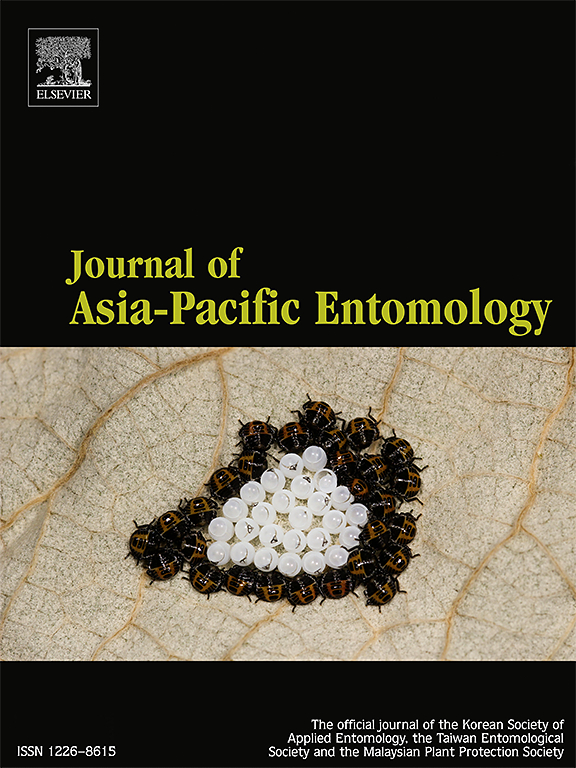菲律宾新埃西亚岛虻虻种群中伊文氏锥虫和巴贝斯虫/伊氏伊勒菌的分子检测(双翅目:虻科
IF 1.3
3区 农林科学
Q3 ENTOMOLOGY
引用次数: 0
摘要
吸血蝇属虻科(双翅目),是危害动物和人类健康的重要害虫和多种疾病的传播媒介。本研究确定了虻在巴贝斯虫、伊氏伊勒氏虫和伊氏锥虫等原生动物传播中的潜在作用。在Brgy的后院农场附近安装了Nzi陷阱。Catalanacan,科学城Muñoz, Nueva Ecija,菲律宾,从2023年5月到6月收集tabanids。记录了收集到的虻的种类、相对丰度和密度。采用聚合酶链反应(PCR)法检测虻解剖喙中伊文氏杆菌(n = 383)和伊氏杆菌/巴贝斯虫(n = 382)的发生情况。在伊文氏杆菌和伊氏杆菌/巴贝斯虫呈阳性的样本中,也确定存在人血,作为人类可能暴露于原虫的指标。共捕获虻4317只,分属小虻(99.95%,4315 / 4317)和小虻(99.95%,4315 / 4317)。减少(0.05%,2/4,317)。常规PCR检测结果显示,该地区伊文氏杆菌和巴贝斯氏伊勒氏菌感染率分别为47.26%(181/383)和31.15%(119/382)。在6.01%(23/383)的长鼻中检测到这两种情况。对12份阳性标本进行测序,鉴定为泰利菌属。在其中一种或两种原虫阳性的样本中,约有18.41%(51/277)可检出人血,表明研究地区曾有人被tabanids叮咬,从而表明存在暴露于携带血液原虫的tabanids的风险。本文章由计算机程序翻译,如有差异,请以英文原文为准。

Molecular detection of Trypanosoma evansi and Theileria/Babesia sp. in Tabanus spp. populations (Diptera: Tabanidae) from Nueva Ecija, Philippines
Hematophagous flies of the family Tabanidae (Order Diptera) are important nuisance pests and vectors of several diseases in both animals and humans. In this study, the potential role of tabanids in the transmission of protozoans such as Babesia sp., Theileria sp. and Trypanosoma evansi was determined. Nzi traps were installed near backyard farms in Brgy. Catalanacan, Science City of Muñoz, Nueva Ecija, Philippines from May to June 2023 for the collection of tabanids. The species, relative abundance, and density of the collected tabanids were recorded. While the occurrence of Tr. evansi (n = 383) and Theileria/Babesia sp. (n = 382) in the dissected proboscis of tabanids were determined using polymerase chain reaction (PCR). The presence of human blood among the samples that were positive for Tr. evansi and Theileria/Babesia sp. was also determined as an indicator of potential human exposure to the protozoans. A total of 4,317 tabanids were collected belonging to Tabanus partitus (99.95 %, 4,315/4,317) and Ta. reducens (0.05 %, 2/4,317). Using conventional PCR, the occurrences for Tr. evansi and Theileria/Babesia sp. were 47.26 % (181/383) and 31.15 % (119/382) in Ta. partitus, respectively, while both were detected in 6.01 % (23/383) of the proboscis. Twelve samples that were positive for Theileria/Babesia sp. were subjected to sequencing and were found to belong to the genus Theileria. About 18.41 % (51/277) of the samples positive for either or both protozoans have detectable human blood, indicating that humans have been bitten by tabanids in the study area, thus demonstrating the risk of exposure to hemoprotozoan-carrying tabanids.
求助全文
通过发布文献求助,成功后即可免费获取论文全文。
去求助
来源期刊

Journal of Asia-pacific Entomology
Agricultural and Biological Sciences-Insect Science
CiteScore
2.70
自引率
6.70%
发文量
152
审稿时长
69 days
期刊介绍:
The journal publishes original research papers, review articles and short communications in the basic and applied area concerning insects, mites or other arthropods and nematodes of economic importance in agriculture, forestry, industry, human and animal health, and natural resource and environment management, and is the official journal of the Korean Society of Applied Entomology and the Taiwan Entomological Society.
 求助内容:
求助内容: 应助结果提醒方式:
应助结果提醒方式:


